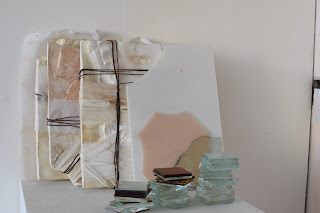Outpost 050822
The Thinking Field/Speculative Curriculums.
The Body-In-Action/Making Spaces between Art, Architecture, Archaeology and Anthropology.
Sequences of actions that add up to an observational-heuristic procedure.
Conserved without restoration of lost detail.
The problem of historical materials, which we can never ignore but can't imitate directly either, is an issue that has always concerned me. I am primarily interested not in any concepts of restoration but an idea to do with historical clarity, making history visible by the co-existence of overlaying fragments of construction.
Carlo Scarpa, Castelvecchio.
Lime Wash, Field Chalk, China Clay.
Human Figure Drawing.
Waxed Paper, Canvas.
Charcoal, Clay, Liquid Iron Oxide.
Essential Work Only.
The SPAB Approach.
The Society's approach very often involves carefully considered inaction.
Where no problems exist, or where a problem has no major effect on use or conservation, an old building is best left alone and simply enjoyed.
Problems need to be tackled, but the society encourages work which is no more, but no less, than is essential.
Restricting work to these things helps ensure the maximum survival of historic fabric.
Site Sequencing/The Infra-Thin/The Viewing Chamber.
Tactically posed surrounds that contrast/entangle one segment of world with another.
Mapping Photons/Subjectivity.
Architectural Body/Collaged Users
Procedural Movements of Conservation/Care and Repair.
Extracting that which has become interred.
Observing quotidian detail within the ruins of a fabric of building.
Domestic and intimate details that create poetic themes that are universal and transcendent.
Wanting to see what things look like photographed/interrogations.
Pushing the photographic image to the point of failure, using the fading twilight to create new abstractions of light and movement.
The intermediate space of the negative.
A gap created between the mechanical attentive and unassumptive nature/vision of the camera and the presumptive and subjective vision of the human eye.
In The Visible and the Invisible Merleau Ponty struggled with the development of a theory of vision that would take account our embodied relationship to it, describing the 'chiastic' relationship between the viewer and the world, an intertwining through which the world was bought into a kind of visibility.
What needed to be put into question and seen as problematic was how the viewer came to be seen as separate from the world, how the visual ever became positioned as something other, something differentiated and separate from the spectator.
The force of presence/presentness.
Stillness and Time, 2006.
Still Video Portraits and the Account of The Soul.
Joanna Lowry.
The Visual, is predicated upon the construction of a distance between the spectator and the world, a distance maintained through the work of culture and the work of technology.
Photographic technologies have provided one key cultural mechanism for defining the place of the visual and positioning it in relationship to us.
In representing the subject they also define the site of the subjects's visibility, the place at which he or she can be seen.
They cut through the world, interrupt it, producing difference and distance and projecting it onto the surface of the paper or the screen.
They produce a differentiated space of the visible within which the subject and the spectator are made aware of their otherness and their distance from from each other.
Photographic Drawings/Haiku.
Luminous/Insubstantial Spectral Abstractions.
Focus and detail would drag it back to our world.
Vision is the place where are continuity with the world conceals itself, the place where we mistake our contact for distance, imagining that seeing is a substitute for, rather than a mode of, touching, and it is this anaesthesia, this senselessness, at the heart of transparency that demands our acknowledgement and pushes our dealings with the visual beyond recognition.
Stephen Melville.
Recombinant Poetics
Pinhole Photography/Qualitative Visual/Haptic Soundings.
St Martins, Shotesham. SPAB
Camera Room/Still Life
Paintings from the overlaying intervals of materials and processes of construction.
The Essential Solitude
Maurice Blanchot
Self Communion.
The person who is writing the work is thrust to one side, the person who has written the work is dismissed. What is more, the person who is dismissed does not know it.
This ignorance saves him, diverts him and allows him to go on.
The writer never knows if the work is done.
What he has finished in one book, he begins again or destroys in another.

.jpg)


No comments:
Post a Comment